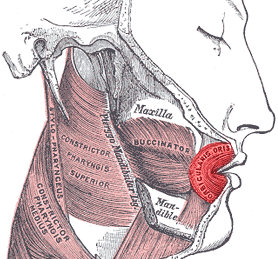
Last week, I talked about the complexities of the lip muscles and how some movements of the lips and mouth, things like doing a zerbert, require activating more than just one muscle. There is one muscle though that is pertinent to just about every movement of the lips, especially the kiss!
The orbicularis oris surrounds the mouth, bringing life to the lips. Though it has been traditionally thought to be a sphincter muscle, by definition the description no longer seems to fit as this muscle operates in more ways than a sphincter muscle does. There appears to be contrasting opinions about orbicularis oris’ attachment points. Some research showed that the muscle attaches from the maxilla and mandible bones (the upper and lower jaw bones) to the lips while other research stated that the obicularis oris attaches from the muscle fibers surrounding the lips to the skin at the corners of the mouth. Either way, it is important to note that the fibers of the orbicularis oris run deep and can act independently.

In fact, for years cleft lip repair had focused on a simple repair of the orbicularis oris in order to improve the appearance of the lip, which it did. But, in motion the lip abnormally changed shape and, with age, it became distorted. One study utilizing cadavers with cleft lip repairs found “two different components in the orbicularis oris muscle, a superficial and a deep component. One is a retractor and the other is a constrictor of the lip. They have antagonistic actions to each other during lip movement.” The doctors decided that accuracy in the repair of the orbicularis oris, meaning – not mixing the fibers of these different mechanisms during reattachment, was of utmost importance so that “better results in the dynamic and three-dimensional configuration of the upper lip can be achieved, and unfavorable distortion can be avoided as the patients grow.” The doctors tried this in surgery with favorable results!
While the orbicularis oris may be best known as the muscle of the kiss, it does much more than pucker up the lips. Contracting this muscle helps to narrow, round, protrude, and close the lips. Think of all the things that require the lips to take action: eating your breakfast, whistling your favorite tune, sucking a straw stuck in your smoothie, breathing with a stuffy nose (think parted lips), zerberting your babies, and speaking – especially labial sounds or letters like “b”, “m”, and “p” that require complete or partial closure of both lips.
Injury to the orbicularis oris can cause pain, fatigue and drooling (remember what it was like to sip water after the dentist anesthetized your gums?). An injured orbicularis oris can put trumpet players, opera singers, and anyone else who depends on their lips out of work. One trumpet player had so overused his puckered lips playing “two to three shows a day for eight days” that he ruptured his lip!
Puckerers beware and take care of those lips! Besides trying to engage the various muscles of the mouth and making funny faces at yourself in the mirror like I suggested last week, you can also do some gentle Yoga Tune Up® Therapy Ball rolling of these muscles. While I don’t recommend that you roll directly on the lips during self face massage, you can skin roll around your lips since there are many muscles (see list below for further details), including:
- Buccinator
- Depressor anguli oris
- Levator anguli oris
- Obicularis oris
- Risorius
- Zygomaticus major
All of which attach to the skin or fascia at the corners of the mouth. Here is a quick video of me demonstrating a couple of the ways that you can do this.
It’s been a while now since I’ve listened to that TED Talk and tried the mouth/vocal exercises in it that I discussed in last week’s post, but I’ll never forget the dismay I felt when I realized that I could no longer move my mouth in a way that I used to. If you don’t use it (insert muscle), you may lose it (insert action/movement). Obviously, it had been a while since I pretended to be a chug boat or given anyone a zerbert. If you asked my husband, he’d say that I wasn’t kissing him enough! I now realize it’s important to do so on a regular basis. Why? Because I’ve learned that keeping the facial muscles active and moving helps to keep the face symmetrical, enhance eating, and may improve speaking skills like enunciation and articulation. I recently practiced the vocal warm up exercises before teaching a class. Doing so did help me to feel less tongue tied and speak more fluidly. Why not exercise your face muscles right now. Pucker up to the person next to you, or better yet, give them a zerbert!













This was such an interesting article! I have friend’s whose children have had the cleft lip surgery multiple times and I didn’t understand why until reading this! The chart of facial muscles is so helpful! I’m curious if mouth breathers have weaker orbicularis oris muscles? There has been recent research about the changes in oral structure with mouth breathing.
Thanks to your great video, I discovered some hidden tension around my mouth in the obicularis oris muscle. I haven’t thought of using the yoga tune up balls over this important area. The exercise chart is a helpful tool to use to tone our facial muscles. Thank you!
Awesome information here! I’m sure most of us take the actions of this important muscles for granted. My husband is a professional brass musician, and he is very careful when playing a casual game of pick up basketball because his lips are his living! The chart you included lists moves that I likely don’t do on a regular basis, but now I will. Thanks!
Love doing the ball therapy to my face – it instantly relieves my facial tension, and that makes me feel more relaxed too.
I learned a multi-step facial yoga this weekend. Your text on the orbicularis oris of the mouth and other muscles and your self-massage video are very timely. Thank you!
I’m one of those students who has to be reminded to relax my face! Happy to learn some ways to roll those facial muscles.
This is an awesome article! I’ve never thought to roll the ball on my facial muscle! I’ve learned a lot of the muscle that shape our faces and can’t wait to geek out some more. Facial exercises feels weird, goofy, funny and gooood!
I love your article. And the video, too. So rarely do we speak about or give attention to our facial muscles, even though they constitute the very first impression that we give of ourselves to other people. And they seem to be connected to so many emotional expressions of the body. Even when moving through ordinary Yoga poses do we use those facial muscles, too. I always remind my students to relax their face muscles at least twice in every Yoga class. Once in Tadasana, and once in Savasana. It’s important to also increase proprioception in the face. I will try the ball movement you present in your video and I appreciate the depth and detail of the information you provide in your post.
This is great! For some reason it never occurred to me that facial asymmetry could be caused by muscle imbalances too, but why wouldn’t it if the rest of the body is like that? I’m definitely trying your rolling techniques!
I’ve suffered from bells palsy twice now and it seems to affect the nerves and muscles around my mouth the most. Looking for ideas and remedies to help restrenghten and restore the use of these muscles.
Wow! I didn’t realize how much one little muscle was in charge of and how important it is for making different facial expressions. Really great tips on how to roll the face and the skin in and around the lips. I imagine this would be really great for anyone with scar tissue built up and creating sensory output to this forgotten area of the body.
Wow! i never thought about rolling your face and mouth until this moment. Also so much I didn’t realize this little muscle is in charge of. I thought the scar tissue aspect and direction of fibers was interesting with how a cleft lip is fixed.
Thank you so much for sharing this info. As someone who talks A LOT (professionally and socially). This is such a great way to bring awareness and relieve tension in an area that can get very knotted up. This will be great to share with my trumpet playing husband as well. 😉
Great read and video was super helpful to visual the possibilities of using the therapy balls on the facial muscles. Anatomy chart with DOMs for the face is super helpful.
This is great! I’m new to rolling and never considered rolling the muscles of the face… but why not? Thank you for the useful article, video and chart.
Thank you for the helpful video and the chart with the prime movers of the actions of the face! I am really interested in facial massage, particularly after taking a workshop with the creator of Province Apothecary about their 5-minute natural facelift, and was curious about if YTU balls could help target expression lines. The technique you’ve used in the video is actually similar to a move they do around the mouth so my hypothesis is yes!
Wow. I have never even thought of using the tune up balls for the muscles in your mouth/ face. I actually have TMJ which causes a lot of pain in the muscles of my mouth. This will be helpful for me to use the ball for my lower jaw for depressor angulus oris.
Very interesting thank you!
I have been going to do a Face Yoga class with my students. Thanks for the ideas
Love the video!!! I release my face muscles and my jaw a lot but I have never thought about releasing my lip muscles! I bet this will help with the smile line as well 😉 Thanks!
I love finding different ways to use my therapy balls! Thank you for the video. As a working actor we train our mouths a lot. For me, I tend to think of my jaw and my tongue as that’s where I store tension. Thinking about your “kissing” muscle makes it applicable to everyone. Great transfer of learning point!
While the entire post was informative just as the previous post, my favorite part was the video and how to utilize the therapy balls.
This is wonderful! We don’t pay much attention to these small and specialized muscles. I sometimes have jaw problems from clenching, and I usually just focus on my masseters and nearby neck muscles. I’m going to add these treatments of the muscles surrounding the mouth to my regular self-care.
I loved this blog! I’m a yoga teacher and use my body so much everyday… but I never thought of exercising my face! Thank you for the inspiration.